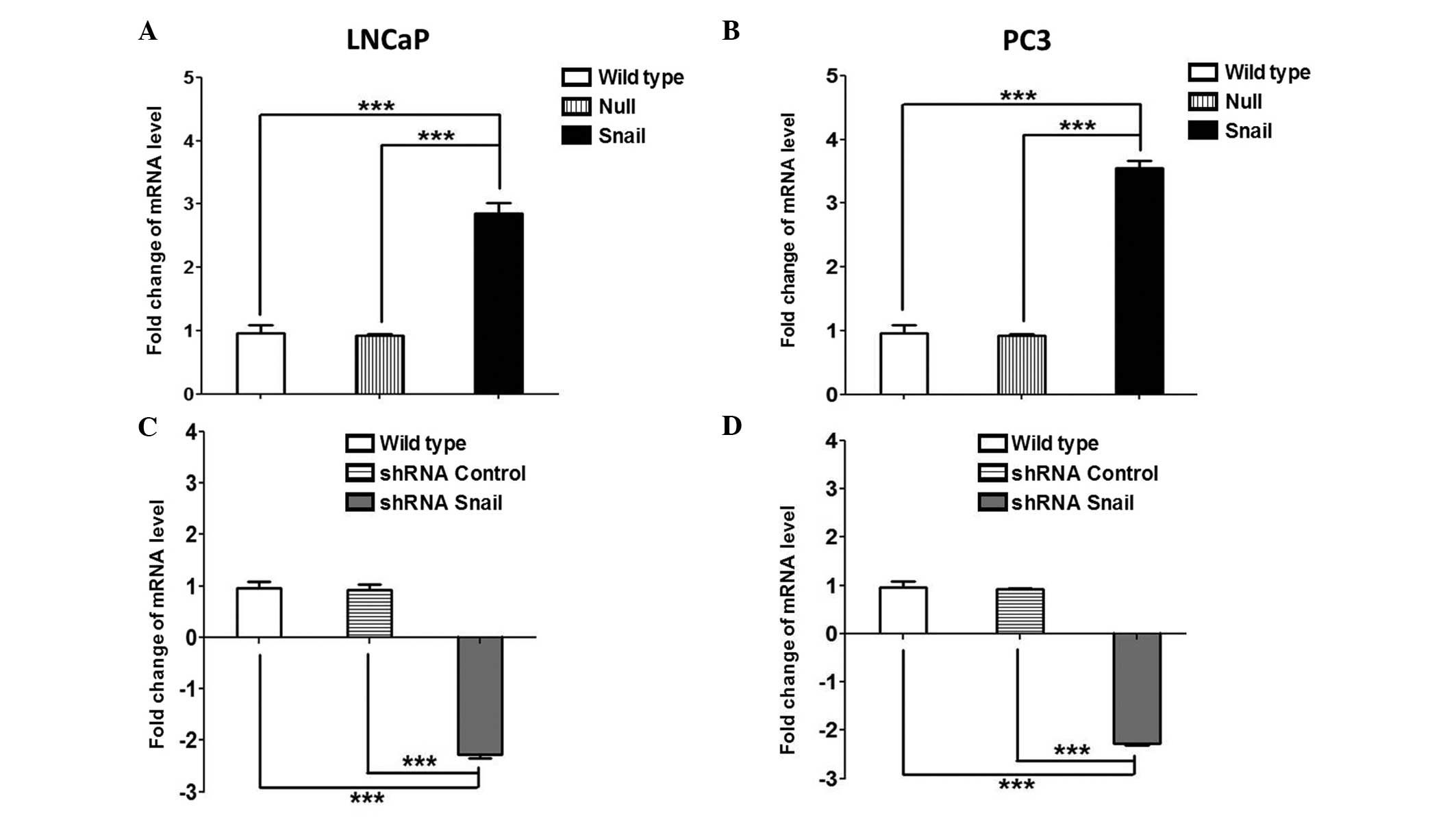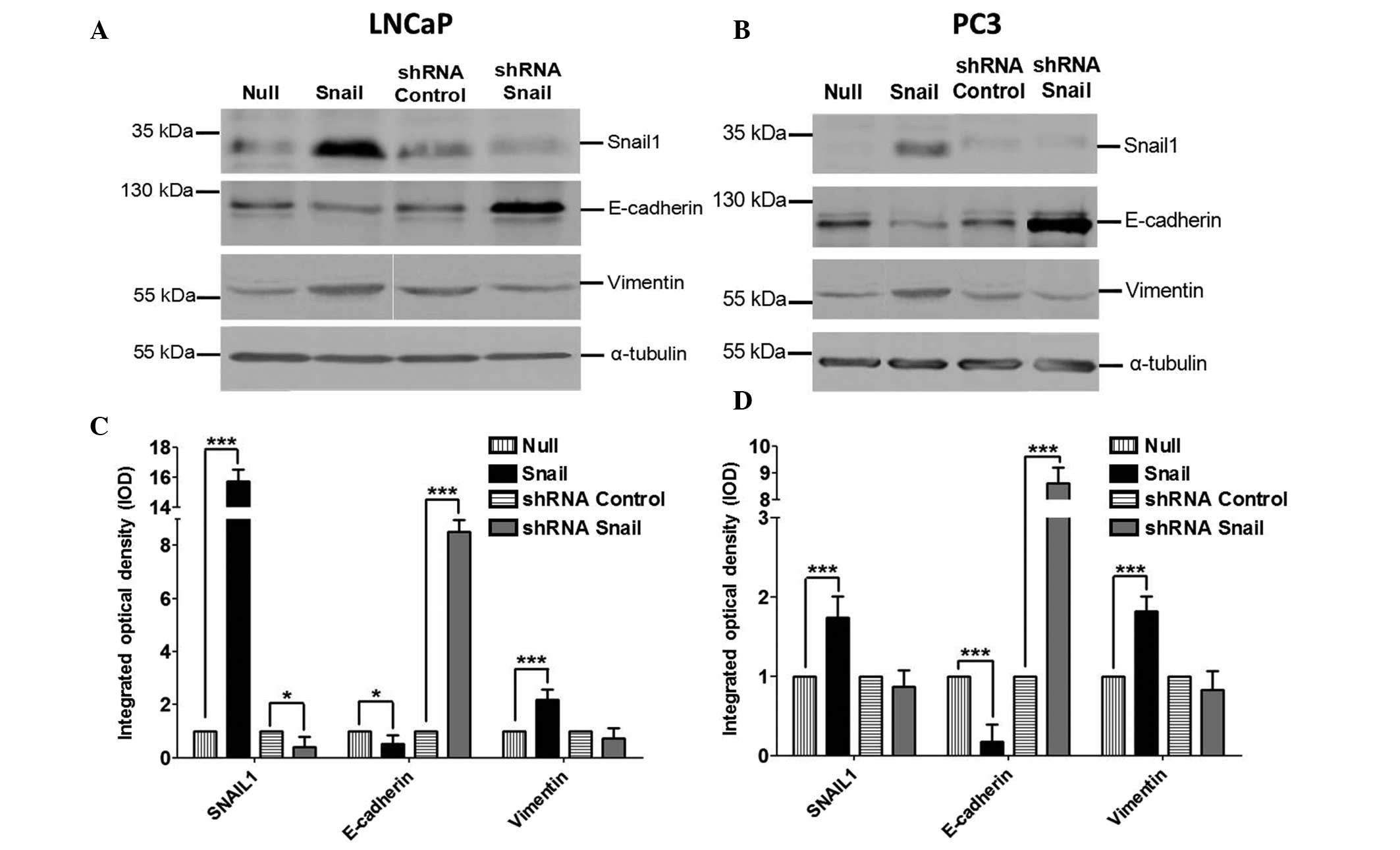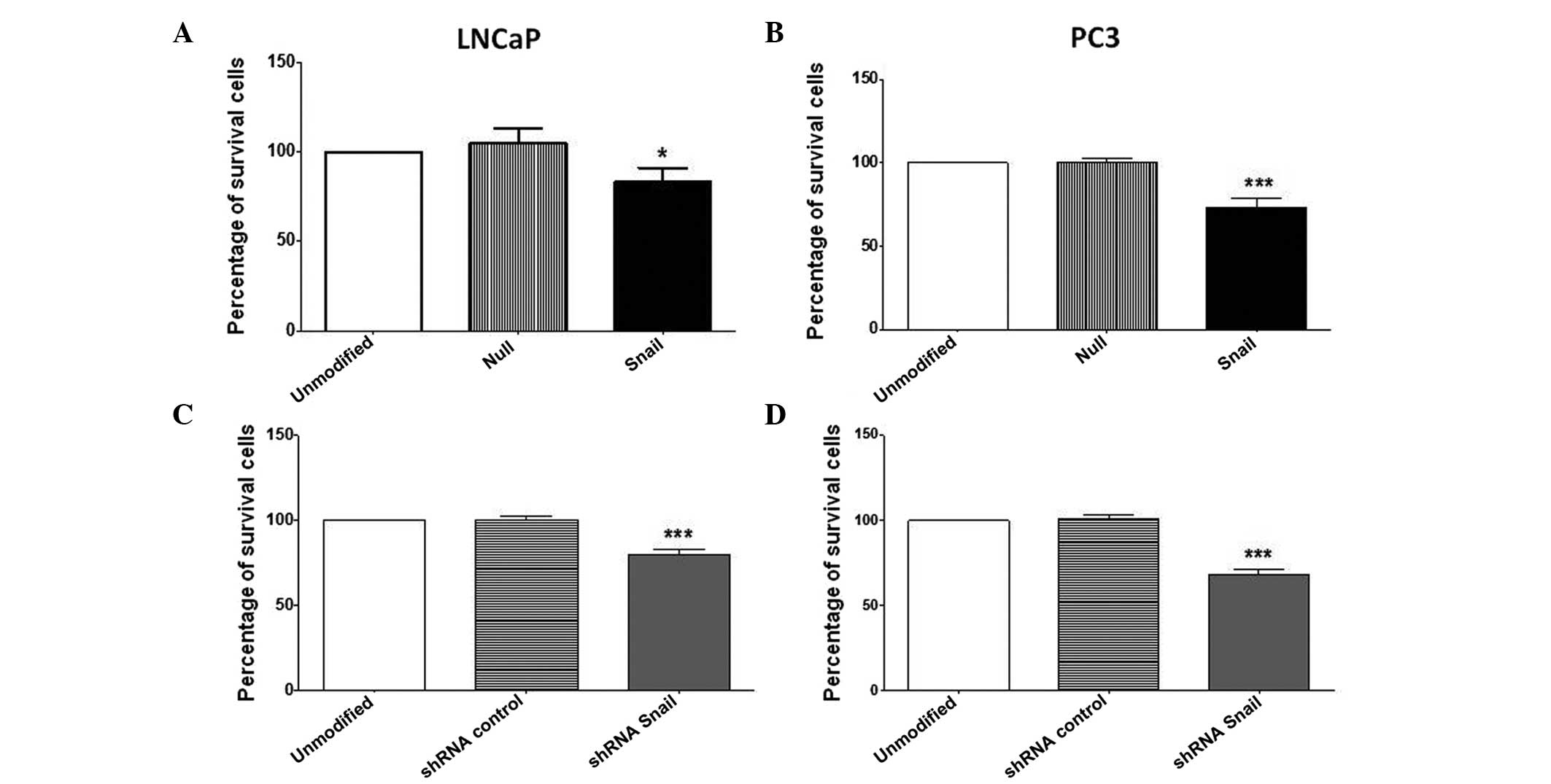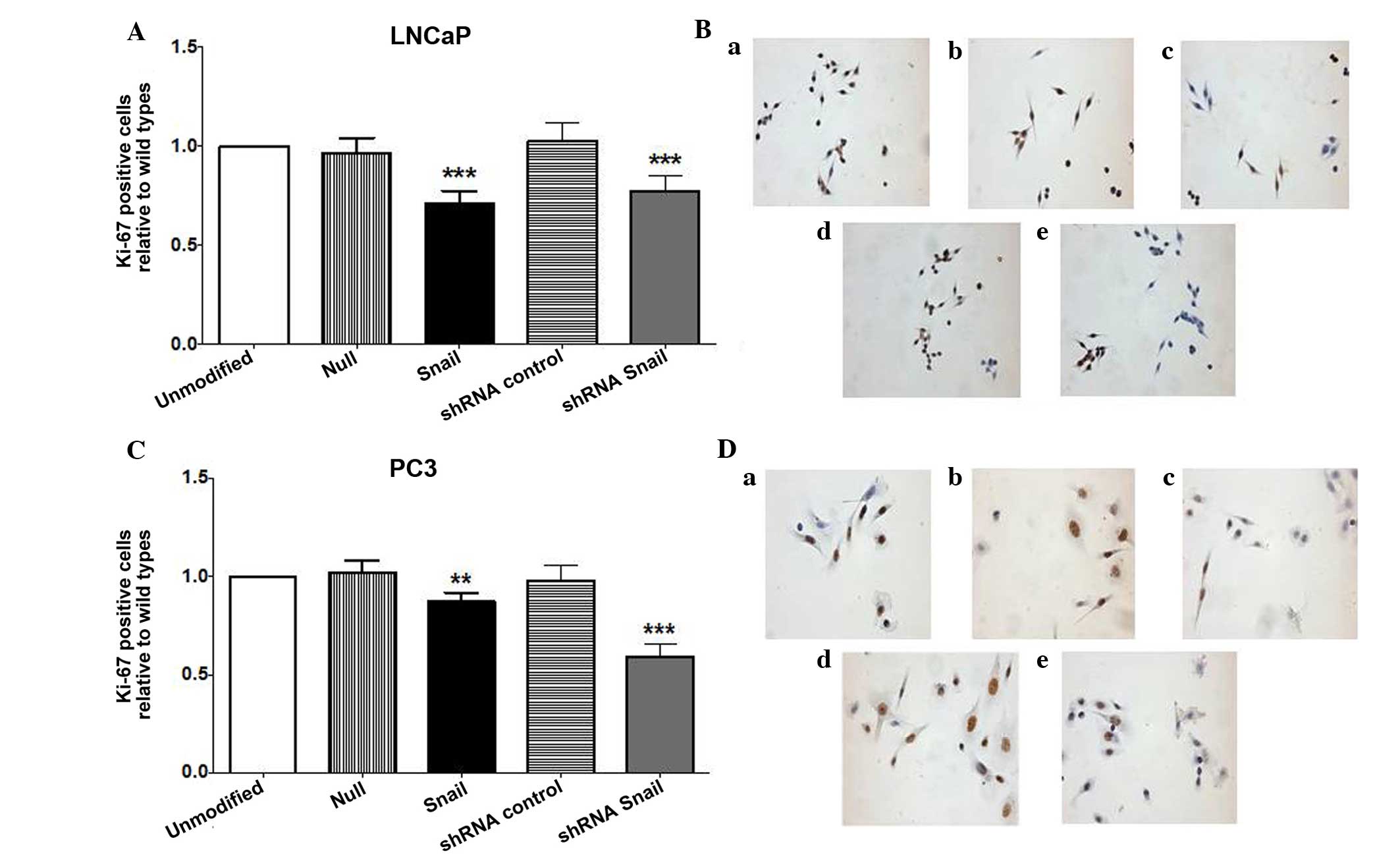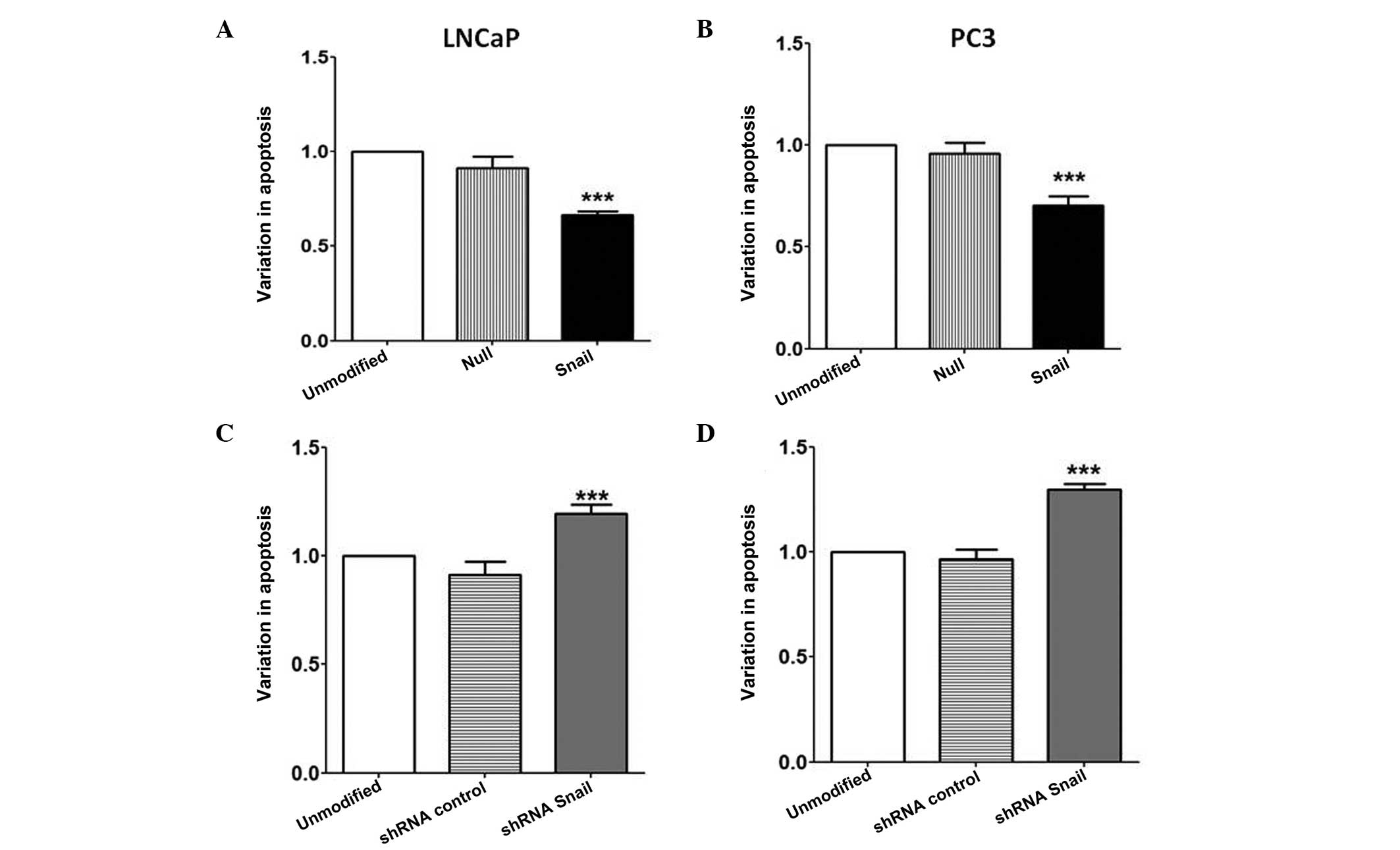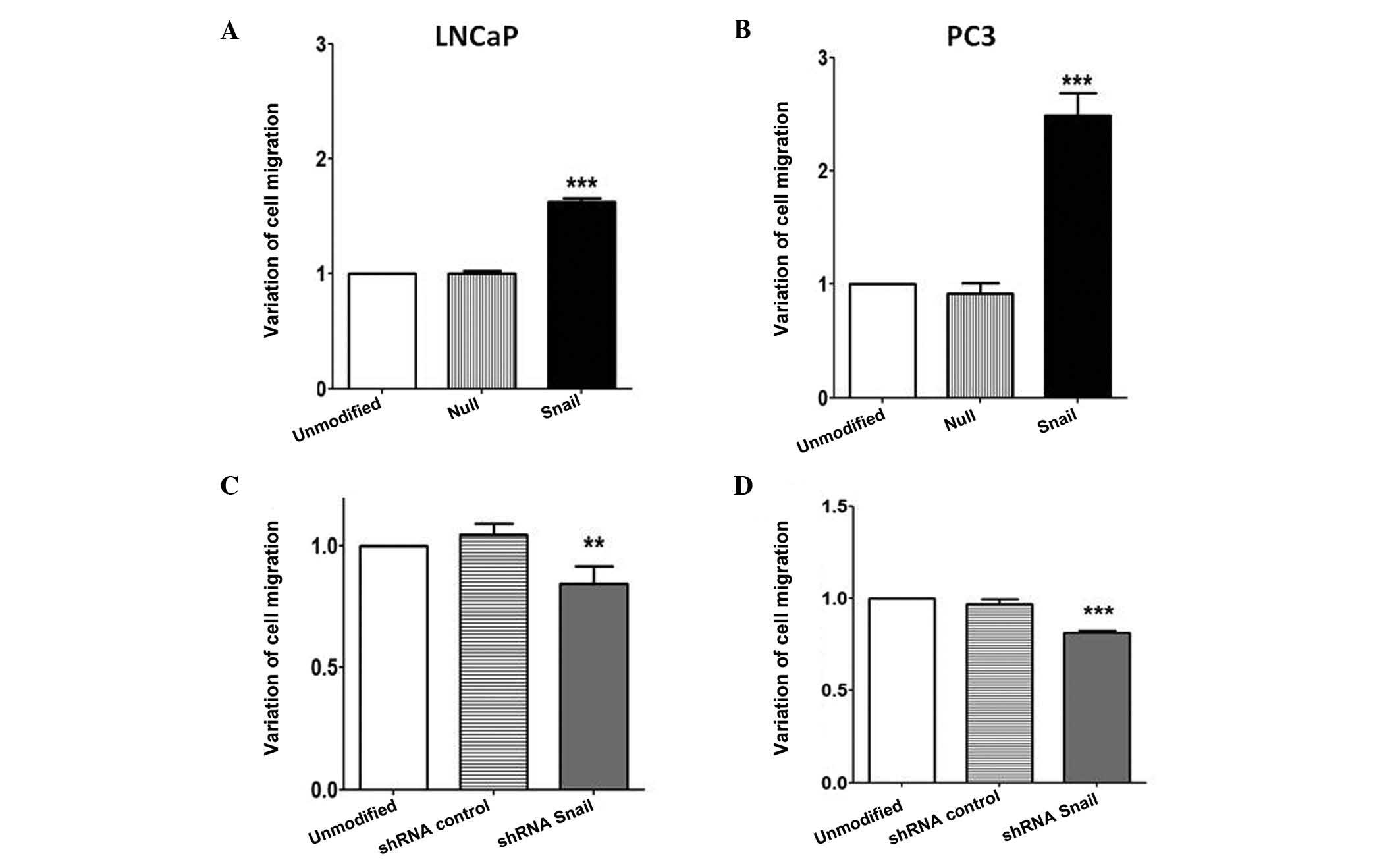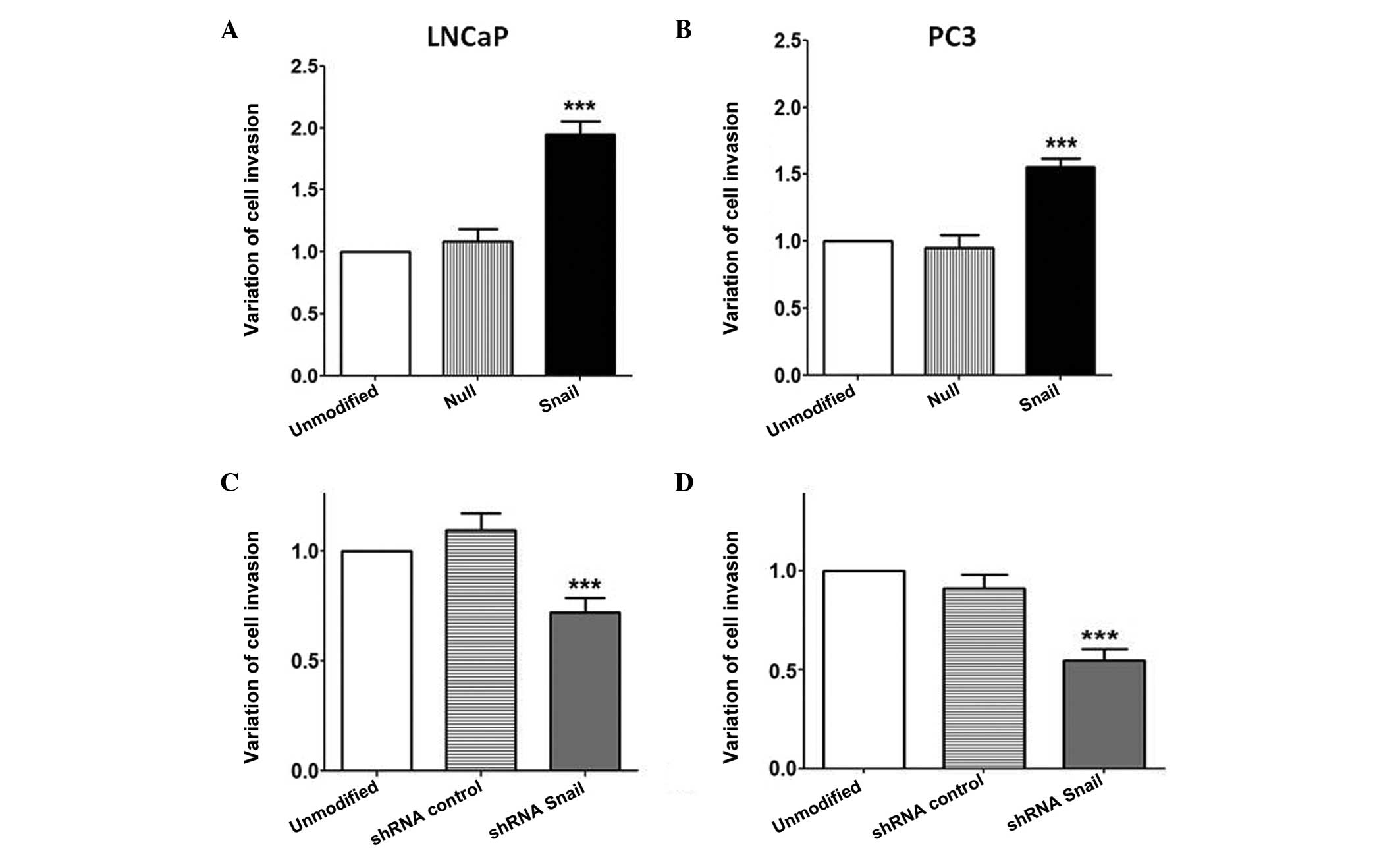Introduction
The predominant diseases affecting the prostate
gland are prostatitis, resulting from inflammation by infection;
benign prostatic hyperplasia, which develops in the transition
zone; and prostate cancer (PCa), which occurs predominantly in the
peripheral area (1). It has been
established that PCa develops from prostatic intra-epithelial
neoplasia, and is preferentially located in the peripheral zone of
the prostate (1,2).
The heterogeneity of PCa is important as it allows
the distinction between latent and clinical stages, as well as the
progression of PCa. The progression of PCa involves
de-differentiation of epithelial cells, which lose their
organization and adopt a migratory and invasive phenotype (1,3).
Epithelial mesenchymal transition (EMT) is a
biological process, which allows polarized epithelial cell
interacting with the basal lamina to initiate biochemical changes,
which result in a mesenchymal phenotype (4). Among the most important changes are
increases in the migration capacity, invasiveness, resistance to
apoptosis and production of extracellular matrix (ECM) components
(4).
Different molecular mechanisms are involved the
initiation of EMT, including the activation of transcription
factors, expression of specific cell surface proteins,
rearrangement and expression of cytoskeleton proteins, production
of ECM-degrading enzymes, including metalloproteinases (MMPs), and
changes in the expression of specific microRNAs (miRNAs; miRs)
(5).
The physiological and morphogenetic changes that
characterize EMT, including decreased expression levels of
epithelial genes, such as E-cadherin/cadherin 1, and increased
expression levels of mesenchymal genes, such as vimentin, are
regulated by transcriptional regulators belonging to the SNAIL
(SNAIL1, SLUG and SMUC), zinc finger E-box binding homeobox (ZEB)
and TWIST families (5). These
changes are associated with variation in epithelial cell morphology
(loss of apical-basal polarity), to a migratory phenotype (5,6).
Inducing stimuli in the tumor microenvironment,
including hypoxia, and various growth factors, including
transforming growth factor β, fibroblast growth factor and
insulin-like growth factor 1, activate specific intracellular
downstream signaling pathways. These signaling pathways, including
mitogen-activated protein kinase (MAPK), small mothers against
decapentaplegic (Smad), glycogen synthase 3, and nuclear factor-κB
components result in increased activity of the ZEB family of
transcriptional repressors, TWIST and SNAIL, which downregulate the
mRNA expression levels of E-cadherin and other epithelial cell
adhesion proteins. Furthermore, these factors indirectly induce the
expression of other mesenchymal proteins (6). Epigenetic mechanisms associated with
histone lysine methyltransferase promote EMT, whereas miRNAs,
including miR-101 or miR-200, may be involved in the maintenance of
the epithelial state (5).
A previous study demonstrated that cancer cells
acquire a mesenchymal phenotype and express markers, including
α-smooth muscle actin (α-SMA), fibroblast-specific protein 1,
vimentin and desmin (7). These
cells are predominantly located at the invasive front of primary
tumors, and are considered to be the cells that are ultimately
involved in the later stages of invasion-metastasis, including
intravasation, transport through the circulation, extravasation,
micrometastasis formation and the establishment of macrometastasis
(4,7). The induction of EMT is an important
process in the progression of metastatic carcinomas (7,8).
It has been reported that the onset of EMT is
dependent on a number of networks of intracellular mechanisms
involving the signaling proteins, extracellular signal-regulated
kinase, MAPK, phosphoinositide 3-kinase, Akt, Smads, Ras homolog
family member B, β-catenin, factor enhancer binding lymphoid, Ras
and c-Fos, and the cell surface proteins, β4 integrin,
α5β1 and αVβ6 (9). Activation of EMT is also facilitated
by the disruption of cell-cell adhesion junctions and cell-mediated
ECM integrins (4).
In patients with castration-resistant PCa,
circulating tumor cells coexpressing epithelial markers
(E-cadherin) and mesenchymal markers (vimentin, N-cadherin and
O-cadherin) have been identified (10). This suggests the in vivo
presence of an intermediate EMT phenotype (10). Another previous study showed that
the epithelial marker, E-cadherin, and mesenchymal marker,
vimentin, are coexpressed in metastatic prostate tissue, suggesting
plasticity between EMT and mesenchymal epithelial transition (MET)
in a in vivo context (11).
Previous analyses of gene expression profiles using
micro-arrays determined that SNAIL1 increases, compared with that
in normal prostatic epithelium, in metastatic CaP (12,13).
In addition, immunohistochemical studies have shown that the
expression levels of SNAIL1 increase with the progression of PCa
(14,15). The SNAIL1 transcription factor has
been associated with advanced stages of PCa and a higher Gleason
score (13,15,16).
Furthermore, our previous study demonstrated using
immunohistochemistry the existence of a direct correlation between
elevated expression levels of SNAIL1 and Gleason score (17). In PCa cells, SNAIL1 negatively
regulates the expression of the tumor suppressor, mammary serine
protease inhibitor, by suppressing the activity of its promoter,
which leads to increased cell migration and invasion (16). Similarly, in metastatic PCa cell
lines, SNAIL1 suppresses the expression of protein kinase Raf,
which has been characterized as a metastasis suppressor protein
(13). Furthermore, SNAIL1
decreases cell proliferation by repressing the expression of cyclin
D2, and SLUG, another member of the Snail family is a negative
regulator of PCa cell proliferation as it suppresses the expression
of cyclin D1 (18).
The present study investigated the effects of the
SNAIL1 transcription factor on the proliferative, migratory and
invasive capacities of PCa cell lines. This study aimed to
determine whether the transcription factor SNAIL1 is important for
EMT in prostate cancer cell lines and how it influences in the
proliferative, migratory and invasive capacities. Silencing SNAIL1
in LNCaP and PC3 cells led to a MET-like process, increasing
epithelial characteristics and decreasing tumor cell migration and
invasion. Thus SNAIL1 silencing may be considered as a therapeutic
target in metastatic CaP.
Materials and methods
Cell culture
In the present study, the LNCaP PCa cell line (cat.
no. CRL-1740; American Type Culture Collection, Manassas, VA, USA)
and PC3 cell line (cat. no. CRL-1435; American Type Culture
Collection) were used. The LNCaP and PC3 cell lines were maintained
in RPMI and Dulbecco's modified Eagle's medium (DMEM)/F-12 (Thermo
Fisher Scientific Inc., Waltham, MA, USA) supplemented with 10%
fetal bovine serum (Mediatech, Manassas, VA, USA), respectively.
Transduced cells were selected in culture medium containing 2 µg/ml
puromycin (Santa Cruz Biotechnology Inc., Santa Cruz Biotechnology,
Inc., Dallas, TX, USA) and incubated at 37°C in an atmosphere
containing 5% CO2. For the functional assays, the cells
were detached with a solution of 2 mM ethylenediaminetetraacetic
acid (Calbiochem; EMD Millipore, Billerica, MA, USA) in 1X
phosphate-buffered saline (PBS).
Cell transduction
Lentiviral particles were obtained from GenTarget,
Inc. (San Diego, CA, USA). The overexpression vectors containing
short hairpin (sh)RNA for SNAIL1 were designed based on the
nucleotide sequence (NM_005985.3) obtained from the GenBank
database (http://www.ncbi.nlm.nih.gov/genbank/). Transduction
was performed in 6-well plates seeded with 7.5×104 LNCaP
or PC3 cells/well. A ViraDuctin™ Lentivirus Transduction kit (Cell
Biolabs, Inc., San Diego, CA, USA), at a multiplicity of infection
of three was used to facilitate transduction according to the
manufacturer's instructions. The experimental design and vectors
used are summarized in Table
I.
 | Table ILentiviral vectors used for cellular
transduction. |
Table I
Lentiviral vectors used for cellular
transduction.
| Lentiviral
vector | Name |
|---|
| pLenti-suCMV
(SNAI1)-Rsv | Snail |
| pLenti-suCMV-Rsv | Null |
| pLenti-U6-shRNA
(SNAI1)#1/#2/#3-Rsv | shRNA Snail |
| pLenti-U6-shRNA
(Control-Neg)-Rsv | shRNA control |
Total protein extraction and western blot
analysis
Cells (400 cells/ml) at 70% confluence in 10 mm
plates were treated with radioimmunoprecipitation assay lysis
buffer, containing 20 mM Tris-HCl, 150 mM NaCl, 1 mM ethylene
glycol tetra-acetic acid, 1% NP-40 v/v, 1% sodium deoxycholate w/v,
2.5 mM Na3PO4, 1 mM β-glycerophosphate and 1
mM Na3VO4 (pH 7.4), in the presence of
protease inhibitors (Roche Diagnostics, Basel, Switzerland; cat.
no. 11-836-170-001) at 4°C. The homogenates were centrifuged at
18,000 × g for 15 min at 4°C. The supernatants were subsequently
collected and quantified using the standard Bradford method. The
protein samples were heated at 96°C for 5 min, prior to being
separated by 10% SDS-PAGE with electrophoresis at 100 V for 3 h.
The proteins (50 µg) were then transferred onto a nitrocellulose
membrane (0.45 µm pore; Bio-Rad Laboratories, Inc., Hercules, CA,
USA) at 300 mA for 1.5 h at 4°C. The membrane was blocked for 1 h
at room temperature with 10% bovine serum albumin (BSA;
Sigma-Aldrich, St. Louis, MO, USA) in Tris-buffered saline with
0.1% 1X-Tween 20, comprising 100 mM Tris-HCl, 0.9% NaCl and 0.1%
Tween-20 (pH 7.5). The membranes were then incubated with the
following primary antibodies: Monoclonal rabbit anti-SNAIL1 (Cell
Signaling Technology, Inc., Danvers, MA, USA; cat. no. 3879;
1:1,000), mouse monoclonal anti-E-cadherin (1:1,000; BD
Biosciences, Franklin Lakes, NJ, USA; cat. no. 610181), mouse
monoclonal anti-vimentin (1:500; Abcam, Cambridge, UK; cat. no.
ab8978) and rabbit polyclonal anti-α-tubulin, which served as a
loading control (1:1,000; Santa Cruz Biotechnology, Inc.; cat. no.
sc-58668). Incubation with the respective primary antibody was
performed overnight at 4°C with stirring. Membranes were then
washed three times with Tris-buffered saline with Tween-20 0.05%
for 5 min. Subsequently, the membranes were incubated with the
corresponding horseradish peroxidase (HRP)-conjugated polyclonal
goat anti-mouse IgG (1:5,000; cat. no. 115-035-003), anti-rabbit
(cat. no. 111-035-003) or polyclonal goat anti rabbit IgG (1:5,000;
cat. no. 305-035-045) secondary antibodies (all from Jackson
Immunoresearch, Inc., West Grove, PA, USA) for 1 h at room
temperature. HRP enzyme activity was analyzed using enhanced
chemiluminescence (Biological Industries Israel Beit-Haemek Ltd.,
Kibbutz Beit-Haemek, Israel). The membrane was visualized using a
fluorescence imaging system (Mini ChemiScope 3400; Clinx Science
Instruments Co., Ltd., Shanghai, China). Densitometric analysis of
bands was performed with the Gel Pro Analyzer 4.5 (Media
Cybernetics, Inc., Rockville, MD, USA).
RNA and reverse
transcription-quantitative polymerase chain reaction (RT-qPCR)
Cells were lysed with TRIzol (Gibco, Thermo Fisher
Scientific, Inc.) for RNA extraction according to the
manufacturer's instructions. Briefly, RNA was isolated by phase
separation using chloroform, precipitated with isopropanol, washed
with ethanol and resuspended in diethylpyrocarbonate-treated water.
RNA was quantified using SynergyTM HT Multi-Mode Microplate Reader
(Biotek Instruments, Inc., Winooski, VT, USA). From 1 µg RNA
reverse transcription was performed using the AffinityScript QPCR
cDNA Synthesis kit (Agilent Technologies, Santa Clara, CA, USA)
according to the manufacturer's instructions. The real-time PCR mix
was prepared with SYBR Select Master mix (Applied Biosystems,
Thermo Fisher Scientific Inc.). The following forward and reverse
primers were used: Forward: 5′-GAGCTGCAGGACTCTAATCCAGAG-3′ and
reverse: 5′-AGCCTGGAGATCCTTGGCCTCAG-3′ for SNAIL1; forward:
5′-GACGATGACTACGCTTCTGC-3′ and reverse: 5′-T TGTATCCTCTTCGGCTGG-3′
for SDC-1; forward: 5′-GGTGCTCTTCCAGGAACCTC-3′ and reverse:
5′-TAAGCGATGGCGCATTGTA-3′ for E-cadherin, forward:
5′-GGACAGTTCCTGAGGGATCA-3′ and reverse: 5′-GGATTGCCTTCCATGTCTGT-3′
for N-cadherin; and forward: 5′-CCATCACCATCTTCCAGGAG-3′ and
reverse: 5′-CCGCCGAACATCCTGCGGTA-3′ for glyceraldehyde 3-phosphate
dehydrogenase (housekeeping gene). The PCR reaction conditions were
as follows: 1 cycle at 90°C for 10 min, followed by 40 cycles of
95°C for 15 sec, 60°C for 15 sec and 72°C for 15 sec; and 1 cycle
of 95°C for 15 sec, 60°C for 15 sec and 95°C for 15 sec. The
experiments were performed in triplicate for each sample. The
relative quantification in gene expression was determined using the
2−ΔΔCq method (19) and
the fold changes in gene expression were normalized to a
housekeeping gene.
Cell proliferation analysis based on
Ki-67 marker
To determine cell proliferation, two silanized
slides, which had been subjected to ultraviolet radiation (1300
Series Class II; Thermo Fisher Scientific, Inc.)for 30 min per
side, were each placed on a 100 mm plate. A total of
1×106 cells were subsequently plated and cultured for 24
h under the same conditions described in the above method.
Endogenous peroxidase activity was inhibited using a solution of
hydrogen peroxide in 2% methanol for 30 min. The samples were
subsequently washed three times with 1X PBS, blocked with a
solution of 1% BSA in PBS, and finally incubated overnight with
anti-Ki67 (cat. no. M7240; Dako, Glostrup, Denmark) at 4°C. The
following day the samples were washed three times with 1X PBS,
prior to staining using a Vectastain Elite ABC kit (Vector
Laboratories, Inc., Burlingame, CA, USA; cat. no. PK-7200). The
samples were washed again with 1X PBS and incubated for 2 min with
the DAB substrate (Invitrogen DAB-Plus kit (Thermo Fisher
Scientific, Inc.; cat. no. 00-2020). Finally, the nuclei were
counterstained with hematoxylin (Cell Marque; Sigma-Aldrich) and
the samples were observed at a magnification of x400 using a Leica
DM-2500 microscope (Leica Microsystems GmbH). The percentage of
cells positive for Ki-67 was calculated by counting the number of
stained cells (brown) and number of total cells in five
randomly-selected fields.
Cell survival assay
A Kit 96® CellTiter Aqueous One Solution
Cell Proliferation assay (Promega Corporation, Madison, WI, USA)
was used for cell survival analysis. A total of 1.5×104
cells/well were plated in a 96-well plate. Measurements were
performed after 24 h. The MTS in the kit is reduced to formazan
(colored) by dehydrogenases of metabolically active cells. The
quantity of formazan, determined by absorbance at 490 nm, is
proportional to the number of living cells in the culture. The
absorbance was measured using a Synergy™ HT Multi-Mode microplate
reader (Bioteke Corporation, Beijing, China). The absorbance of the
untransduced was considered as 100% survival.
Apoptosis assay
A total of 1.5×104 cells of the two cell
lines, with SNAIL1 overexpression and silencing, were seeded on a
white 96-well plate. The activities of capases 3 and 7 after 24 h
were measured using an Apo-ONE® Kit Homogeneous
Caspase-3/7 assay (Promega Corporation). Fluorescence was detected
using a Synergy™ HT Multi-Mode microplate reader (Bioteke
Corporation). The data were normalized to control non-transduced
cells.
Cell migration and invasion assay
A cell migration and invasion assay was performed
using a CytoSelect kit™ (Cell Biolabs, Inc.), according to the
manufacturer's protocol. The polycarbonate wells contained
membranes with pores 8 µm in size to allow cell migration. The
plates used to assess invasiveness also contained membranes with
pores 8 µm in size, and were coated with basement membrane. The
cells (5×104 cells/well) were allowed to migrate and
invade for 24 h. Each assay was performed in triplicate. Detection
of the cells was based on relative fluorescence units. Fluorescence
was detected using a Synergy™ HT Multi-Mode microplate reader
(Bioteke Corporation). The data were normalized to the untransduced
control cells.
Statistical analysis
The results of the present study were analyzed using
a one-way analysis of variance and Dunn's post hoc test. Results
are presented as the mean ± standard deviation. Statistical
evaluation of the data was performed using GraphPad Prism software
6.0 (GraphPad Software, Inc., La Jolla, CA, USA). P<0.05 was
considered to indicate a statistically significant difference.
Results
Effects of SNAIL1 on the expression
levels of EMT markers in LNCaP and PC3 cells
To determine the effect of SNAIL1 on EMT markers,
the LNCaP and PC3 cells were transduced with specific lentiviral
vectors. The mRNA expression levels of SNAIL1 increased in the
cells transduced with the overexpression vector (Fig. 1A and B), whereas the mRNA
expression levels of SNAIL1 decreased in the cells transduced with
the silencing vector (Fig. 1C and
D). Similar results were observed in the two cell lines.
The effects of SNAIL1 overexpression on the
expression levels of epithelial and mesenchymal markers were
evaluated using western blot analysis and RT-qPCR. Elevated
expression levels of SNAIL1 were associated with a significant
decrease in the expression levels of E-cadherin, which may result
from the repressor function of SNAIL1 in the nucleus. Furthermore,
high expression levels of SNAIL1 significantly increased the
expression of vimentin. These results were similar in the LNCaP and
PC3 cell lines. (Fig. 2). The same
effect was observed in the two cell lines when the mRNA expression
levels were evaluated (data not shown). SNAIL1 silencing in the
LNCaP and PC3 cells resulted in a significant increase in the
expression levels of E-cadherin and decreased expression levels of
vimentin (Fig. 2). These data
suggested that the overexpression of SNAIL1 induced EMT in the two
PCa cell lines, whereas SNAIL1 silencing led to upregulated
epithelial gene expression levels.
Following transduction with the
SNAIL1-overexpression lentiviral vector, the morphology of the
cells gradually became fusiform in shape, similar to fibroblasts,
which was accompanied by a loss of cell-cell contact. By contrast,
the cells transduced with the empty vector (null) retained their
epithelial morphology. These results suggested that overexpression
of SNAIL1 in the LNCaP and PC3 cells was sufficient to induce a
mesenchymal morphology. By contrast, the PC3 and LNCaP cells
transduced with the shRNA-Snail lentiviral vector, causing SNAIL1
mRNA degradation, exhibited an epithelial morphology, and formed
compact cluster with apparent cell-cell contact. These changes were
more noticeable in the PC3 cells than in the LNCaP cells. The cells
transduced with shRNA control maintained their initial morphology
(data not shown).
Effects of SNAIL1 on the survival,
proliferation and apoptosis of LNCaP and PC3 cells
In the two cell lines, SNAIL1 overexpression
significantly decreased cell survival (Fig. 3). The effect of SNAIL1
overexpression and silencing on cell proliferation was also
evaluated by examining the expression levels of Ki-67 (Fig. 4). SNAIL1 significantly decreased
the levels of these two parameters in the LNCaP and PC3 cells.
Furthermore, assessment of apoptosis was performed
by detecting the activity levels of caspases 3 and 7 (Fig. 5). The results demonstrated a
decrease in the rate of cell apoptosis following SNAIL1
overexpression. However, cells with SNAIL1 silencing (shRNA-snail)
exhibited increases apoptosis.
Effects of SNAIL1 on the migration and
invasive capacities of the LNCaP and PC3 cells
In the cells overexpressing SNAIL1, a significant
increase in cell migration was observed. This effect was reversed
in the cells treated with shRNA Snail (Fig. 6). Similar effects were observed
between the LNCaP and PC3 cells. Furthermore, a cell invasion assay
(Fig. 7) revealed that the cells
overexpressing SNAIL1 exhibited a significant increase in cell
invasion, whereas SNAIL1 silencing significantly reduced the
invasive capacity of the two cell lines.
Discussion
The results of the present study demonstrated the
effects of overexpression and silencing of the SNAIL1 transcription
factor on certain functional properties of LNCaP and PC3 cells. The
data suggested that the overexpression of SNAIL1 in cell lines
induced morphological changes from an epithelial phenotype to a
fibroblastoid phenotype, decreased the expression levels of
E-cadherin and increased those of vimentin, increased migration and
invasion, and decreased proliferation, survival and apoptosis.
These changes are closely associated with the EMT. Furthermore, the
results of the present study were concordant with those of a
previous study by Li et al (20), in which the overexpression of
SNAIL1 in retinal pigment epithelium cells resulted in decreased
expression levels of the epithelial marker, E-cadherin, and
increased the expression levels of the fibronectin and α-SMA
mesenchymal markers. In addition to these morphological changes,
migration also increased in the cells overexpressing SNAIL1.
By contrast, silencing of the transcriptional
repressor, SNAIL1, using shRNA Snail cells resulted in an
epithelial phenotype, with increased expression levels of
E-cadherin and decreased expression levels of vimentin. The in
vitro growth of these cells was in the form of clusters,
relative to the null and SNAIL1-overexpressing cells. The silencing
of SNAIL1 led to cells exhibiting decreased proliferation,
survival, migration and invasion, but an increase in apoptosis.
These results were concordant with those reported by Olmeda et
al (21), which demonstrated
that SNAIL1 silencing in Madin-Darby canine kidney epithelial cells
by RNA interference resulted in increased expression levels of
E-cadherin, decreased expression levels of mesenchymal markers and
the inhibition of invasion. Furthermore, it has been reported that
the stable silencing of endogenous SNAIL1 in two carcinoma cell
lines led to a marked reduction in tumor growth in vivo,
accompanied by an increase in tumor differentiation and a
significant decrease in the expression levels of MMP-9, and markers
of angiogenesis and invasiveness (21).
The changes in cell morphology induced by SNAIL1
observed in the present study were concordant with those reported
by Li et al (20). These
changes from an epithelial to a mesenchymal phenotype were induced
by SNAIL1 overexpression. Li et al (20) reported that retinal pigment
epithelial cells change from an epithelial morphology to a
fibroblast-like morphology following SNAIL1 overexpression. By
contrast, silencing of SNAIL1 induced an epithelial morphology,
with growth clusters that differed from those of the control cells,
and the absence of individual cell growth. Similar changes were
reported in a study by Olmeda et al (21), which demonstrated that MDCK cells
with SNAIL1 silencing exhibited an epithelial morphology.
A previous study reported that Snail is involved in
epigenetic CpG DNA methylation of the miR-200 loci, which is
important for the maintenance of the mesenchymal phenotype in MDCK
cells (22). SNAIL1 binds to
consensus sequences, termed E-boxes, which are present in the
E-cadherin promoter, thereby suppressing expression at the
transcriptional level. E-cadherin is a calcium-dependent cell
adhesion molecule, and is critical in the maintenance of the
epithelial phenotype (23).
Decreased expression levels of E-cadherin is considered to be a
characteristic marker of EMT (23). The results of the present study
revealed that SNAIL1 overexpression decreased the expression of
E-cadherin in the LNCaP and PC3 cells. These results suggested that
SNAIL1 altered cell morphology and growth by decreasing the
expression levels of intercellular junctions and molecules,
including E-cadherin. In addition, cells, which initiate EMT also
increase their synthesis of cytoskeletal proteins, including
vimentin (24). In the present
study, the overexpression of SNAIL1 increased the expression levels
of the mesenchymal markers, vimentin, in the LNCaP and PC3 cells.
These data indicated that the overexpression of SNAIL1 induced EMT
in the two cell lines in vitro.
During EMT, epithelial cells have a mesenchymal
phenotype, but they also acquire novel functional properties. The
results of the present study demonstrated that overexpression of
SNAIL1 significantly increased the ability of cells to migrate and
invade. These data were concordant with a similar study, in which
an increase in the migratory and invasive abilities of the PCa cell
lines was observed with SNAIL1 overexpression (25). In addition, cells with SNAIL1
silencing exhibited decreased migration and invasion capabilities,
indicating that this transcription factor was involved in promoting
the metastatic characteristics of migration and invasion.
SNAIL1 regulates G1 transition (early to
late) and the G1/S checkpoint, and the transcriptional
suppression of cyclin D2 and increased expression levels of p21
result in the decreased proliferation of SNAIL1-overexpressing
cells (26). However,
pro-apoptotic DNA fragmentation factor 40, BH3-interacting domain
death agonist, TP53 and caspase 6 genes are repressed by SNAIL1,
which provides the cell with apoptosis resistance (27). By contrast, it has been reported
that SNAIL1 silencing increases the sensitivity of cells to the DNA
damage associated with increased expression levels of pro-apoptotic
factors, identified as SNAIL1 targets (28). In addition, SNAIL1 increases the
promoter activity of pyruvate dehydrogenase kinase 1, which
phosphorylates pyruvate dehydrogenase, thereby decreasing its
activity and the entry of pyruvate into the Krebs cycle (28). It has also been reported that cells
overexpressing SNAIL1 exhibit a decrease in the enzymatic activity
of Krebs cycle components, including aconitase 2, isocitrate
dehydrogenase 2 and succinate dehydrogenase, and the electron
transport chain (Complex II and IV) (28). This mechanism explains the
decreased survival of CaP cell lines overexpressing SNAIL1.
In conclusion, the results of the present study
demonstrated that the SNAIL1 transcription factor id important in
the induction and phenotypic reversion of EMT in PCa cells. SNAIL1
may serve as a potential therapeutic target to decrease the
metastasis of PCa cells. Which anti-apoptotic genes increase
following SNAIL1 silencing requires elucidation, in order to
develop novel targets to increase the apoptosis of cancer
cells.
Acknowledgments
The authors of the present study would like to thank
Ms. Graciela Caroca for her technical assistance. The present study
was supported by grants from the Fondo Nacional de Ciencia y
Tecnología [grant nos. 1151214 and 1110269 to Dr Héctor R
Contreras, and 1140417 to Dr Enrique A Castellón).
References
|
1
|
Shen MM and Abate-Shen C: Molecular
genetics of prostate cancer: New prospects for old challenges.
Genes Dev. 24:1967–2000. 2010. View Article : Google Scholar : PubMed/NCBI
|
|
2
|
De Marzo AM, Platz EA, Sutcliffe S, Xu J,
Grönberg H, Drake CG, Nakai Y, Isaacs WB and Nelson WG:
Inflammation in prostate carcinogenesis. Nat Rev Cancer. 7:256–269.
2007. View
Article : Google Scholar : PubMed/NCBI
|
|
3
|
De Marzo AM, Nelson WG, Isaacs WB and
Epstein JI: Pathological and molecular aspects of prostate cancer.
Lancet. 361:955–964. 2003. View Article : Google Scholar
|
|
4
|
Kalluri R and Weinberg RA: The basics of
epithelial-mesenchymal transition. J Clin Invest. 119:1420–1428.
2009. View
Article : Google Scholar : PubMed/NCBI
|
|
5
|
Nauseef JT and Henry MD:
Epithelial-to-mesenchymal transition in prostate cancer: Paradigm
or puzzle? Nat Rev Urol. 8:428–439. 2011. View Article : Google Scholar : PubMed/NCBI
|
|
6
|
Gavert N and Ben-Ze'ev A:
Epithelial-mesenchymal transition and the invasive potential of
tumors. Trends Mol Med. 14:199–209. 2008. View Article : Google Scholar : PubMed/NCBI
|
|
7
|
Thiery JP: Epithelial-mesenchymal
transitions in tumour progression. Nat Rev Cancer. 2:442–454. 2002.
View Article : Google Scholar : PubMed/NCBI
|
|
8
|
Thiery JP, Acloque H, Huang RY and Nieto
MA: Epithelial-mesenchymal transitions in development and disease.
Cell. 139:871–90. 2009. View Article : Google Scholar : PubMed/NCBI
|
|
9
|
Tse JC and Kalluri R: Mechanisms of
metastasis: Epithelial-to-mesenchymal transition and contribution
of tumor microenvironment. J Cell Biochem. 101:816–829. 2007.
View Article : Google Scholar : PubMed/NCBI
|
|
10
|
Armstrong AJ, Marengo MS, Oltean S, Kemeny
G, Bitting RL, Turnbull JD, Herold CI, Marcom PK, George DJ and
Garcia-Blanco MA: Circulating tumor cells from patients with
advanced prostate and breast cancer display both epithelial and
mesenchymal markers. Mol Cancer Res. 9:997–1007. 2011. View Article : Google Scholar : PubMed/NCBI
|
|
11
|
Chao Y, Wu Q, Acquafondata M, Dhir R and
Wells A: Partial mesenchymal to epithelial reverting transition in
breast and prostate cancer metastases. Cancer Microenviron.
5:19–28. 2012. View Article : Google Scholar :
|
|
12
|
Dhanasekaran SM, Barrette TR, Ghosh D,
Shah R, Varambally S, Kurachi K, Pienta KJ, Rubin MA and Chinnaiyan
AM: Delineation of prognostic biomarkers in prostate cáncer.
Nature. 412:822–826. 2001. View
Article : Google Scholar : PubMed/NCBI
|
|
13
|
Beach S, Tang H, Park S, Dhillon AS,
Keller ET, Kolch W and Yeung KC: Snail is a repressor of RKIP
transcription in metastatic prostate cancer cells. Oncogene.
27:2243–2248. 2008. View Article : Google Scholar
|
|
14
|
Odero-Marah VA, Wang R, Chu G, Zayzafoon
M, Xu J, Shi C, Marshall FF, Zhau HE and Chung LW: Receptor
activator of NF-kappaB Ligand (RANKL) expression is associated with
epithelial to mesenchymal transition in human prostate cancer
cells. Cell Res. 18:858–870. 2008. View Article : Google Scholar : PubMed/NCBI
|
|
15
|
Heebøll S, Borre M, Ottosen PD, Dyrskjøt
L, Orntoft TF and Tørring N: Snail1 is over-expressed in prostate
cancer. APMIS. 117:196–204. 2009. View Article : Google Scholar : PubMed/NCBI
|
|
16
|
Neal CL, Henderson V, Smith BN, McKeithen
D, Graham T, Vo BT and Odero-Marah VA: Snail transcription factor
negatively regulates maspin tumor suppressor in human prostate
cancer cells. BMC Cancer. 12:3362012. View Article : Google Scholar : PubMed/NCBI
|
|
17
|
Poblete CE, Fulla J, Gallardo M, Muñoz V,
Castellón EA, Gallegos I and Contreras HR: Increased SNAIL
expression and low syndecan levels are associated with high Gleason
grade in prostate cancer. Int J Oncol. 44:647–654. 2012.
|
|
18
|
Liu J, Uygur B, Zhang Z, Shao L, Romero D,
Vary C, Ding Q and Wu WS: Slug inhibits proliferation of human
prostate cancer cells via downregulation of cyclin D1 expression.
Prostate. 70:1768–1777. 2010.PubMed/NCBI
|
|
19
|
Livak KJ and Schmittgen TD: Analysis of
relative gene expression data using real-time quantitative PCR and
the 2−ΔΔCt method. Methods. 25:402–408. 2001. View Article : Google Scholar
|
|
20
|
Li H, Li M, Xu D, Zhao C, Liu G and Wang
F: Overexpression of Snail in retinal pigment epithelial triggered
epithelial-mesenchymal transition. Biochem Biophys Res Commun.
446:347–351. 2014. View Article : Google Scholar : PubMed/NCBI
|
|
21
|
Olmeda D, Jordá M, Peinado H, Fabra A and
Cano A: Snail silencing effectively suppresses tumour growth and
invasiveness. Oncogene. 26:1862–1874. 2007. View Article : Google Scholar
|
|
22
|
Díaz-López A, Díaz-Martinez A,
Moreno-Bueno G, Cuevas EP, Santos V, Olmeda D, Portillo F, Palacios
J and Cano A: Zeb1 and Snail1 engage miR-200f transcriptional and
epigenetic regulation during EMT. Int J Cancer. 136:E62–E73. 2015.
View Article : Google Scholar
|
|
23
|
Cano A, Pérez-Moreno MA, Rodrigo I,
Locascio A, Blanco MJ, del Barrio MG, Portillo F and Nieto MA: The
transcription factor snail controls epithelial-mesenchymal
transitions by repressing E-cadherin expression. Nat Cell Biol.
2:76–83. 2002. View
Article : Google Scholar
|
|
24
|
Zeisberg M and Neilson EG: Biomarkers for
epithelial-mesenchymal transitions. J Clin Invest. 119:1429–1437.
2009. View
Article : Google Scholar : PubMed/NCBI
|
|
25
|
Neal CL, McKeithen D and Odero-Marah VA:
Snail negatively regulates cell adhesion to extracellular matrix
and integrin expression via the MAPK pathway in prostate cancer
cells. Cell Adh Migr. 5:249–257. 2011. View Article : Google Scholar : PubMed/NCBI
|
|
26
|
Vega S, Morales AV, Ocaña OH, Valdés F,
Fabregat I and Nieto MA: Snail blocks the cell cycle and confers
resistance to cell death. Genes Dev. 18:1131–1143. 2004. View Article : Google Scholar : PubMed/NCBI
|
|
27
|
Kajita M, McClinic KN and Wade PA:
Aberrant expression of the transcription factors snail and slug
alters the response to genotoxic stress. Mol Cell Biol.
24:7559–7566. 2004. View Article : Google Scholar : PubMed/NCBI
|
|
28
|
Haraguchi M, Indo HP, Iwasaki Y, Iwashita
Y, Fukushige T, Majima HJ, Izumo K, Horiuchi M, Kanekura T,
Furukawa T and Ozawa M: Snail modulates cell metabolism in MDCK
cells. Biochem Biophys Res Commun. 432:618–625. 2013. View Article : Google Scholar : PubMed/NCBI
|















